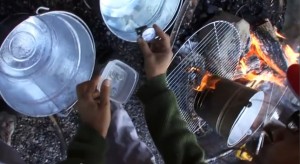Sarah Craske, one of our Chain Reactionists, put me onto this one: BioARTCAMP. There’s also a video of the project. BioARTCAMP was a project run out in the wilds of the Rocky Mountains, bringing together artists and scientists into an unfamiliar and necessarily improvisatory environment. This simple act of transportation has a transformative effect on the behaviours and relationships of the participants; because it’s no-one’s ‘own’ space, they have to figure out the rules and aims of what they do completely afresh. Paul Vanouse, for example, has to figure out how to do PCR in the forest. He has to go without the modern kit: to go back to before the automatic machine we’re exploring in Chain Reaction! was invented. He heats up his water-baths laboriously to the right temperature – over the campfire – barbecues will never seem the same again …
One unexpected element of the video is seeing children run around the camp – whoever saw that in a lab or even in most artists’ studio? In another social reconfiguration, scientists and artists alike are kitted out in the same professional ‘uniform’, a hi-vis jacket decorated with a brassiere image on the front (complete with Canadian maple leaf). And then there’s just weird stuff around the place, like a fridge inside the body of a goat or deer of some sort.
In their turn, these social rearrangements reconfigure relationships with nature, which is after all the stuff of both science and art. The feminised uniforms are echoed in the mating experiments done at the camp by Marta de Menezes (another Chain Reactionist) who unpicks the binary notion of gender with her seven-gendered organism.
Dr Jennifer Willet (director of BioARTCAMP) comments:
The lab itself is an ecology … The laboratory is in fact teaming with life. When we manipulate life in the lab we are in turn manipulating ourselves and our ecology.
What BioARTCAMP does is to get people thinking about how these manipulations can be humane, witty, creative, fun. Artists and scientists alike partake in the same social project, that is, of choosing natural manipulations.
Above all I respect the political angle of BioARTCAMP, which is based in an appreciation that both art and science are at root social projects, and that good science communication digs beneath the science to its purposes. Here’s Willet again:
I’m really interested in a social and political analysis of technology. I’m fearful that as a culture we’re … falling into a future that is not being determined for our best needs or for our ecology’s best needs, but instead for the economy’s best needs, and for the best needs of business men. So with a project like this I’m driven primarily by the images it will create … secondary to that I am driven by the political and social economy of the arguments that we are making with those images.
We could do a lot worse than this for a vision of science communication.


Recent Comments